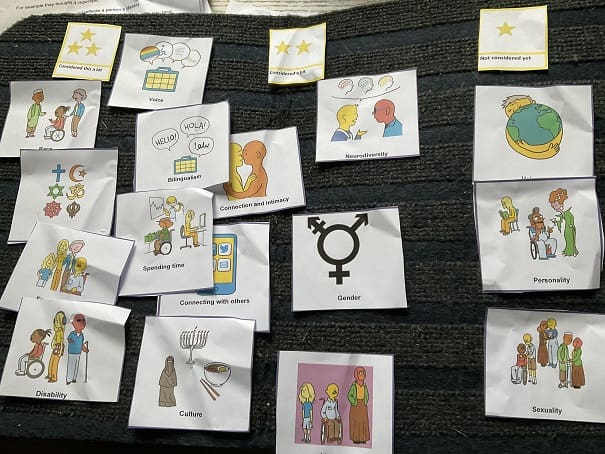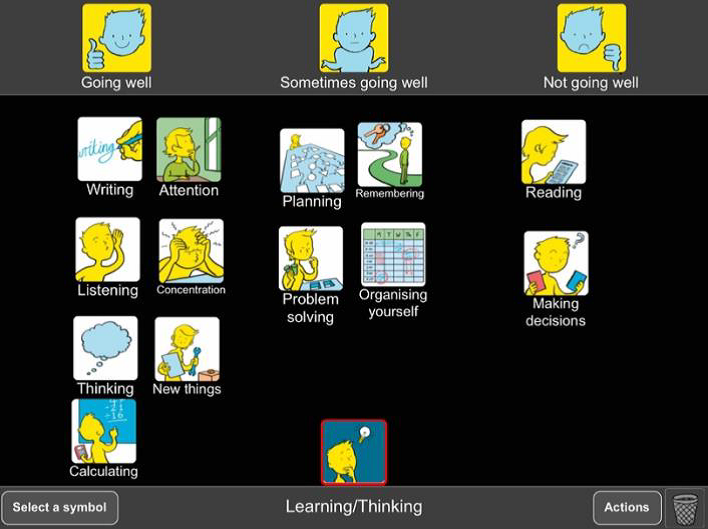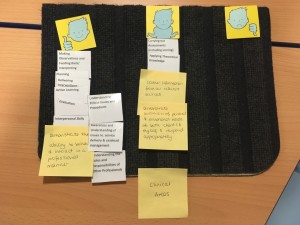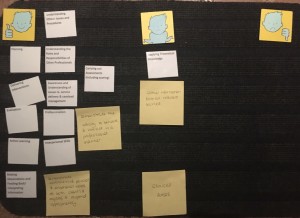The previous blog (read here) described the development of a set of symbols to prompt discussions around identity. In this blog, the authors illustrate how the symbols can be used to support practitioners to consider their own ideas about identity and how this may influence the clinical relationship.
The completed resource was trialled with practitioners working in a variety of settings.
Feedback
‘It help me understand and reflect on my own biases and how I am slowly working to be more aware of them and ask the right questions’
‘This Talking Mat was an eye opener about my worries and anxieties around saying the wrong thing’
Overall practitioners reported that using the resource helped;
• understanding and reflection on own biases and challenge default assumptions
• consideration of wider aspects of identity that were not routinely thought about
• holistic thinking by encouraging seeing clients in a wider context
• stimulate ideas about different questions to ask
• provide a safe platform for staff to open up
• address your own anxieties as a professional about getting it wrong and fear of ”putting your foot in it”.
It was also agreed that the resource could be used in diverse settings and not only within AAC.

Next steps
At the start of the process we were not sure where the discussions with the original project group would lead but the results of the pilot have shown that this Talking Mats identity resource is helpful for practitioners to mindfully reflect on their practice, allow unconscious bias to rise to the surface, consider all aspects of their clients’ identity to develop their practice, contribute to reducing inequalities and improving the responsiveness of services.
If you would like to know more about this resource and how it can support practitioners, please join Lois, Nikki and Lucia for an online webinar on
Tuesday 13th August 2pm – 3.30pm
In our latest blog, Rachel Woolcomb, Talking Mats OT Associate, discusses how Talking Mats can support Reflective Practice for Occupational Therapists.
Taking time out to stop and reflect on our practice can be a challenge. We convince ourselves there are more important things to do, people to see, targets to meet, and therefore we just don’t have the time.
However, I suggest, that with this mind set we are doing ourselves, and the people to whom we provide support and care, a disservice.
Clinical supervision has always been embedded in the culture of occupational therapy and at its best should create a safe and supportive environment in which reflective practice can take place.
Unfortunately, in practice, the reality can look different.
The more I have used Talking Mats to enable my clients to think and express their opinions, the more I have been convinced, that there is also great benefit to them being used within the clinical supervision process.
I want to thank the occupational therapists who agreed to explore this further with me. They used Talking Mats to think about their coping skills at work, or reflected on how their ability to learn and think, impacted their job role.
They were surprised how easy they found it to think about the full breadth of their working life and the impact this had on their wellbeing. As clinicians, we are great at looking after other people and ensuring that their health and wellbeing needs are met, however, we are not so great at caring for ourselves.
The latest TMOT resource provides more information about why and how, Talking Mats can be an effective tool in enabling a reflective thinking space for clinicians. Check it out here: TMOT3 Reflective practice
Give it a go… You are worth it!
To find out more about our Talking Mats resources, check out this link:
https://www.talkingmats.com/shop/
Here Laura Holmes, our North-West England Associate, describes how she used Talking Mats to support mid and end of placement reviews with a Speech and Language Therapy Student:
I am very familiar with using Talking Mats to help the children I work with to express their views and opinions – to give them a voice in terms of therapy planning and to enable the children to think about and share what works for them.
However I recently also used Talking Mats to support a Speech and Language Therapy student who was on placement with me. I introduced the approach to support our discussion during her mid-placement review, and then again, during the final review at the end of her placement.
I introduced a Talking Mat with the topic ‘Clinical Areas’ and the topline question ‘Confident/OK/ Not Confident’. I made up options relating to each clinical assessment area as described in the University Student Handbook/Guidelines.
Here is the mat from the student’s mid – placement review:
And here is the mat from the end of placement review:
The pictures help to show the shift in the student’s confidence from the mid-point of the placement in comparison to the end of the placement.
The first Talking Mat helped us to focus our discussions in terms of what skills needed further support/development during the placement. The second Talking Mat then supported our evaluation of current learning outcomes at the end of the placement, as well as helping to identify key learning outcomes for the student’s next placement.
The student shared that she found Talking Mats a really useful thinking tool to help her to think carefully about her skills and the progress she had made during the placement. This was easier than during a typical face-to-face discussion due to the focus on the mat. The interaction itself was also more relaxed as a result.
My next step will be to introduce use of symbols for topic and options – here are some examples from a Scotland-wide Talking Mats project which involved asking students about their work placements:
We often have members of University and College staff coming to our Foundation Training Courses – find out more about this and other training options we offer here:
https://www.talkingmats.com/training/
If you have any examples of using Talking Mats for student supervision, and would like to share them, it would be great to hear from you! Just email me at laura@talkingmats.com
 Online training login
Online training login 






